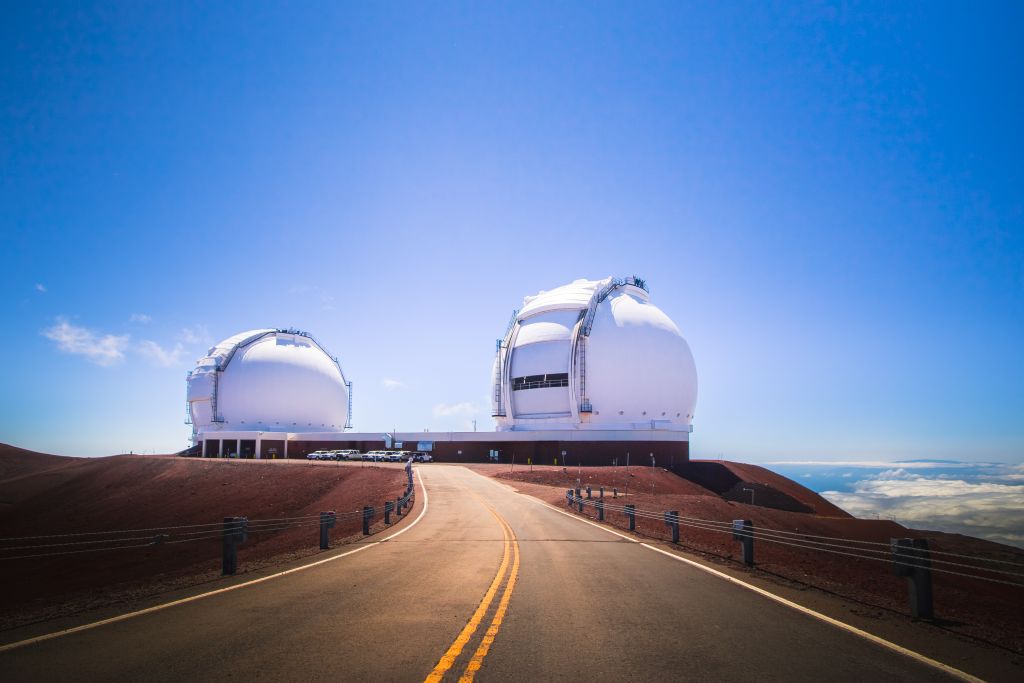

Mauna Kea, often translated as "White Mountain" because it's sometimes capped with snow, is a massive but dormant volcanic peak that rises 13,796 feet (4,205 m) from the Pacific Ocean. But they never made it to the summit, victims of a sociopolitical struggle in Hawaii and NASA's shifting priorities in faraway Washington. EOS Technologies in Tucson, Arizona, built the four telescopes years ago at a cost of about $15 million. NASA gave the project a green light and funding in 1998. It was designed to be the world's most powerful optical interferometer. These four "outriggers" would have given the interferometer the ability to image small patches of sky with unprecedented resolution - down to 30 micro-arcseconds, according to project scientist Rachel Akeson (Jet Propulsion Laboratory) - sufficient to spot Uranus-size planets circling nearby stars. That's because it lacks a quartet of smaller telescopes, each with a 6-foot (1.8-m) primary mirror, that were to be installed alongside the towering twin domes atop Mauna Kea.
KECK OBSERVATORY FULL
"I spent hundreds of nights on the summit from 1998 to 2001 getting this system to work."Īstronomers had planned to add four "outrigger" telescopes, each with 6-foot (1.8-m) apertures, to the existing Keck telescopes.įor all its success, the Keck Interferometer has never lived up to its full potential. "This is tremendously bittersweet to me," van Belle laments. Moreover, it's complicated and expensive to link the giant eyes through a system of optical pathways for just a few dozen nights each year. NASA's official position is that the interferometer has completed its primary task of revealing dusty disks surrounding nearby stars. After that, the two Keck telescopes - which had been designed from the get-go to work together - will stare into the cosmic depths on completely separate schedules. Last summer NASA managers quietly decided to stop funding the interferometer, and it will be mothballed in July. Unfortunately, last week's all-nighter will be his team's final chance to harness the telescopes together. It enabled van Belle to resolve the disks of a few of his target stars - a feat not possible anywhere else. This powerful pairing, called an interferometer, can discern the shape of a grape from 1,000 miles away.
/keckobservatory-5c23f77fc9e77c0001b4c10f.jpg)

But funding for the system will end in mid-2012.īy carefully combining light beams from both telescopes, the observers had effectively transformed the two 33-foot-wide (10-m) primary mirrors into a single, much larger aperture 280 feet (85 m) across. Astronomers have recently overcome the effect of atmospheric blurring using an established and fundamental technique called adaptive optics (AO).Light from the Keck Observatory's twin 33-foot (10-m) telescopes can be combined to create the world's most sensitive optical interferometer. Their performance, and the performance of all ground-based telescopes, is limited by the turbulence of the Earth’s atmosphere, which distorts astronomical images. Few city lights pollute Hawaiian night skies, and for most of the year, the atmosphere above Maunakea is clear, calm and dry.īecause of the large size of the 10-meter primary mirrors, the Keck Observatory telescopes offer the greatest potential sensitivity and clarity available in astronomy. The 13,796-foot Maunakea summit has no nearby mountain ranges to roil the upper atmosphere. In the middle of the Pacific Ocean, Hawai’i Island is surrounded by thousands of miles of thermally stable seas. The telescopes’ primary mirrors are 10 meters in diameter and are each composed of 36 hexagonal segments that work in concert as a single piece of reflective glass. Each telescope stands eight stories tall, weighs 300 tons and operates with nanometer precision. Their instruments are the twin Keck Observatory telescopes-the world’s largest, and most scientifically productive optical and infrared telescopes. From the summit of Hawaii’s dormant Maunakea volcano, UC astronomers probe the local and distant Universe with unprecedented power and precision. UC Observatories acts a managing partner of the W.

Keck Observatory on Maunakea, Hawaii, hosts the world’s largest optical and infrared telescopes.


 0 kommentar(er)
0 kommentar(er)
